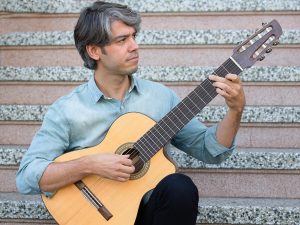with Duo Violão Plus 1
Rogerio Souza, Edinho Gerber, and Ami Molinelli
October 23, 2019, 6pm
CHORO was a collaboration with mentors Duo Violão Plus 1: Brazilian guitarists Roderio Sauza and Edinho Gerber, and San Francisco percussionist Ami Mollinelli. 19 musicians participated in a workshop on traditional Brazilian style and then performed with the trio in concert.
Workshop Participant Resources
Hello!
We are delighted you will be joining us for this special workshop and interactive concert.
Here are all the details you will need and resources to help you prepare.
Event Logistics
Location: Drew School, 2901 Californa Street (at Broderick), San Francisco
Please come to the MAIN ENTRANCE on California Street. Doors will open at 5:30.
What to bring: Your instrument and your music (and a lightweight portable music stand if you have one).
For those who don't have an instrument to bring, we will have some percussion instruments available for you to use for the workshop and performance.
Attire: Dress code is casual/comfortable. Please refrain from wearing scented products such as perfume or hair spray.
A message from our mentors, Duo Violão Plus 1
Maxixe (pronounced Mashishe) is the foundation of Brazilian music, and is based on this repeating rhythm:
![]()
Workshop Music: Brejeiro (1893) by Ernesto Nazareth 1863-1934
From the album História do Choro by Duo Violão Plus 1
For this workshop, take a listen to the music and see what might be fun for you to add. If you play a melody instrument, learn the melody and play along. You might want to just play the rhythm or the bass line and keep the groove going. We'll all learn together at the workshop, so even if you don't have anything prepared, we'll all have a great time together.
Composer Ernesto Nazareth was one of the hardest-working musicians in Rio, and one who bridged the pre-industrial and early industrial stages of Rio's music business. He hustled compositions to the various music publishers around time, played piano in the lobby of the city’s first movie theater, and made some of the first recordings in Rio in the early twentieth century. He survived into the radio era and was one of the musicians featured on Rio’s first station. His music, although extremely pianistic, was able to capture the musical essence of the guitar, flute, and cavaquinho (the traditional choro formation) with such nuance that he was considered a true representative of the soul of Brazil and, more specifically, Rio de Janeiro. Brejeiro, a virtual anthem of Brazilian music, was his first and most famous maxixe. Because the new style was considered too syncopated and scandalous, it was forbidden, leaving Nazareth and other composers to use a more “sophisticated” name: tango brasileiro. It was published in Paris and the US in 1914 and helped maxixe become one of the most fervent dance crazes throughout Europe and the Americas.
Duo Violão Plus 1
A little more about choro music
The emergence and development of choro in the late 19th century was affected by three forms of Brazilian popular music: the modinha, the lundu, and the maxixe. The lundu, an early song and dance genre, and the maxixe, an instrumental dance form that arose concurrently with choro, exhibit African influences. The wildly popular maxixe made an especially strong impression with its close couples dance style and sinuous movements. From its emergence in the late 1870s to its decline in the 1920s, few genres of popular music were as wildly popular, and controversial, as the maxixe. The music accompanies a fast paced couples dance in which the dancers' bodies are pressed together and the legs are often intertwined.
(from Choro Music Blog)
Here are a few additional resources for those who wish to practice some Brazilian rhythm patterns and to learn more about this tradition.
For those who don't have an instrument to bring, we will have some percussion instruments available for you to use for the workshop and performance.
Thank you to our workshop sponsor, Latin Percussion.
If you have questions
Please email us at info@amateurmusic.org and we will get back to you as soon as possible.

 A master of both 6 and 7 string guitars, Rogério Souza is one of the foremost representatives of the music of Rio de Janeiro. Rogério is constantly producing and performing in concerts and events that showcase traditional Brazilian music, especially Samba and Choro. He has worked with a multitude of world class Brazilian Musicians as musical director and producer for concerts, TV shows, CDs, and DVDs. Some of these artists include: Baden Powell, Paulinho da Viola, Sivuca, Ney Matogrosso, Altamiro Carrilho, João Bosco, Paulo Moura, Ivan Lins, Guinga, Turíbio Santos, Rafael Rabello, Cristovão Bastos, Nó em Pingo D’agua, Época de Ouro, Elizeth Cardoso, Elza Soares, João Nogueira, Dona Ivone Lara, Nelson Cavaquinho, Guilherme de Brito, Delcio Carvalho, Martinho da Vila, and Zeca Pagodinho.
A master of both 6 and 7 string guitars, Rogério Souza is one of the foremost representatives of the music of Rio de Janeiro. Rogério is constantly producing and performing in concerts and events that showcase traditional Brazilian music, especially Samba and Choro. He has worked with a multitude of world class Brazilian Musicians as musical director and producer for concerts, TV shows, CDs, and DVDs. Some of these artists include: Baden Powell, Paulinho da Viola, Sivuca, Ney Matogrosso, Altamiro Carrilho, João Bosco, Paulo Moura, Ivan Lins, Guinga, Turíbio Santos, Rafael Rabello, Cristovão Bastos, Nó em Pingo D’agua, Época de Ouro, Elizeth Cardoso, Elza Soares, João Nogueira, Dona Ivone Lara, Nelson Cavaquinho, Guilherme de Brito, Delcio Carvalho, Martinho da Vila, and Zeca Pagodinho. Edinho Gerber possesses a rich musical vocabulary developed in the two countries where he was raised: the United States and Brazil. Navigating effortlessly between the genres of choro, jazz, samba, and blues, he is always in search of the intersection points within his dual cultural identity. A staple in the Chicago music scene for many years, he was a highly in demand sideman having played with countless U.S. based Brazilian groups, including Som Brasil, Renato Anesi Trio, A Cor do Brasil, and led the samba-jazz group Zona Sul. He has performed in prestigious festivals and concerts in throughout the United States, Russia, and Japan, and currently resides in Rio de Janeiro where he performs regularly with Duo Violão Brasil and recently released “Benjamim e Edinho” an inventive cross cultural collaboration with Ben Lamar Gay.
Edinho Gerber possesses a rich musical vocabulary developed in the two countries where he was raised: the United States and Brazil. Navigating effortlessly between the genres of choro, jazz, samba, and blues, he is always in search of the intersection points within his dual cultural identity. A staple in the Chicago music scene for many years, he was a highly in demand sideman having played with countless U.S. based Brazilian groups, including Som Brasil, Renato Anesi Trio, A Cor do Brasil, and led the samba-jazz group Zona Sul. He has performed in prestigious festivals and concerts in throughout the United States, Russia, and Japan, and currently resides in Rio de Janeiro where he performs regularly with Duo Violão Brasil and recently released “Benjamim e Edinho” an inventive cross cultural collaboration with Ben Lamar Gay.
